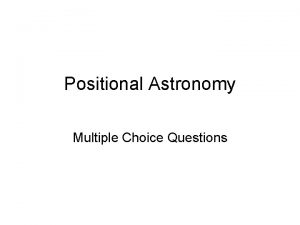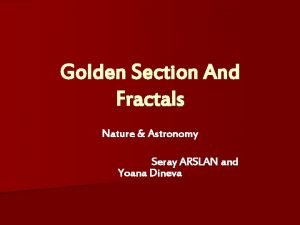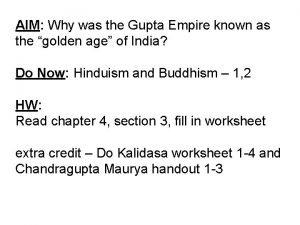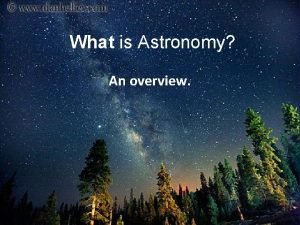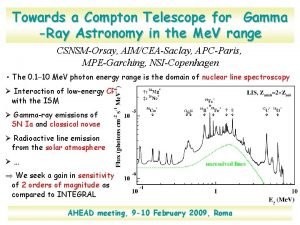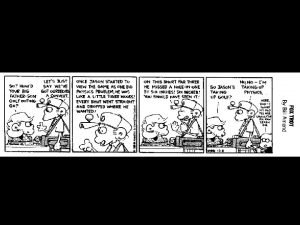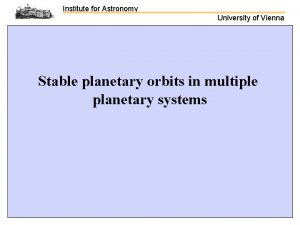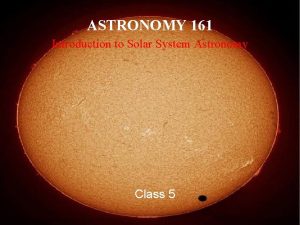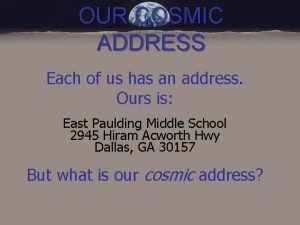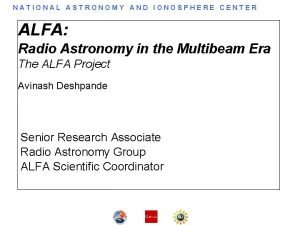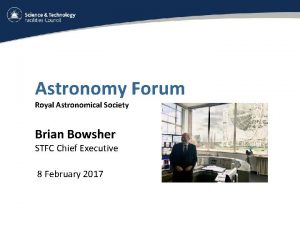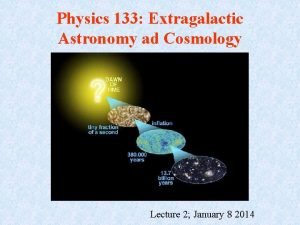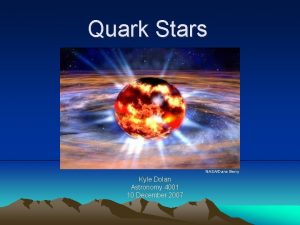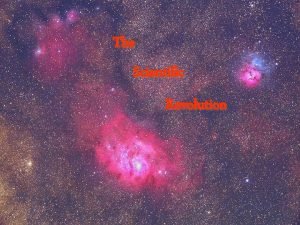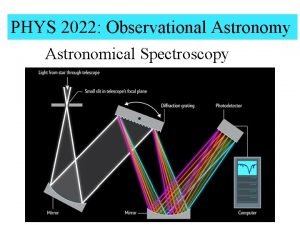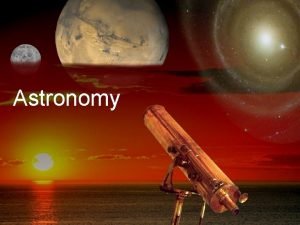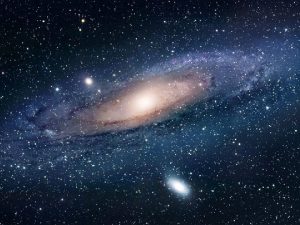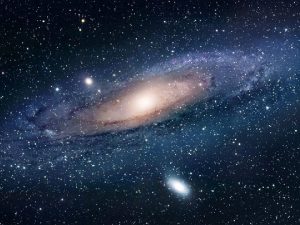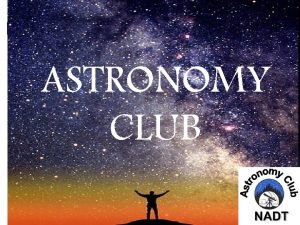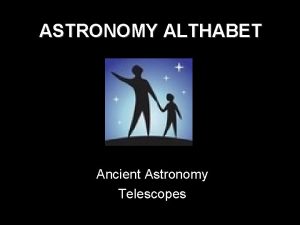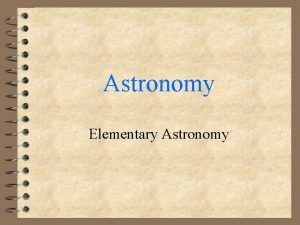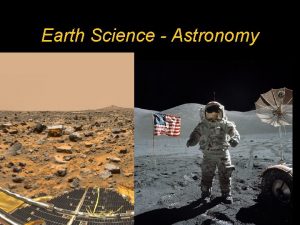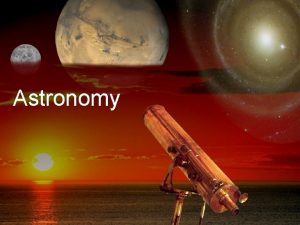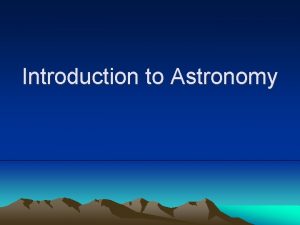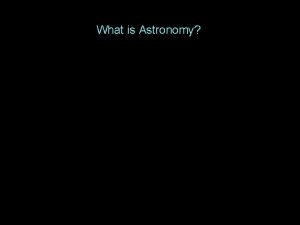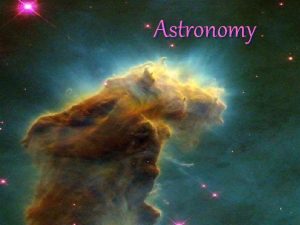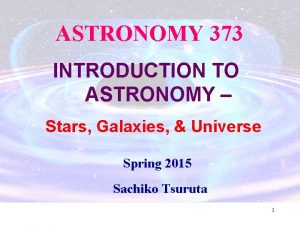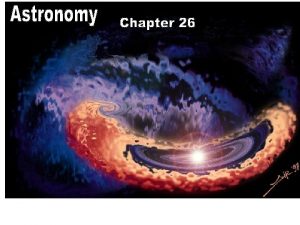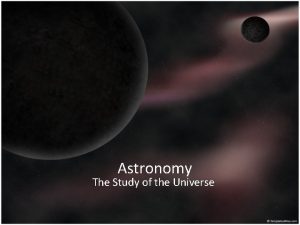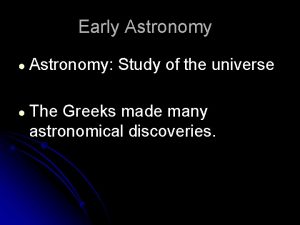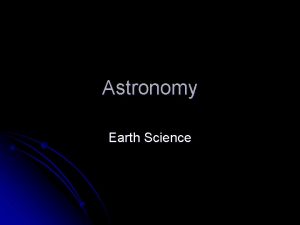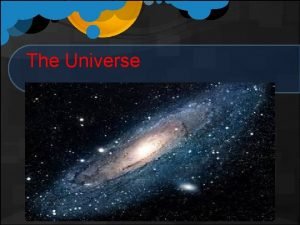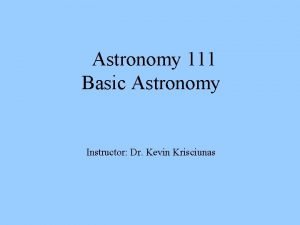Astronomy The Universe The universe is defined as



























- Slides: 27

Astronomy

The Universe The universe is defined as everything that physically exists: the entirety of space and time, all forms of matter, energy and momentum.

How our Universe Formed • Theory of how the universe formed called the Big Bang Theory • Big Bang Theory – the universe formed from a massive expansion approximately 14 bya The Universe is expanding and the visible edge is about 13. 7 billion light years away

The universe began billions of years ago as a tiny dot that exploded into today’s huge system of stars and planets.



Support for the Big Bang Theory https: //www. youtube. com/ watch? v=HY 2 R 2 d 6 AVPM • Red shifts • Cosmic background radiation – Radio signals coming from every direction in space. – Believed to be created by the big bang explosion.

1929 – Edwin Hubble found that the universe is expanding

Hubble’s Law: the more distant galaxies have greater red shifts, therefore they are moving away at faster speeds. https: //www. youtube. com/watch? v=y 5 t. KC 3 n. Ex 2 I

Hubble’s Law

Note: Our solar system is part of a bigger system called a galaxy. Our galaxy is part of a bigger system called the universe Milky Way Galaxy…spiral shaped!

The universe is made up of galaxies. Galaxies are held together by gravity. The galaxy that we are in is the Milky Way Galaxy. Types of Galaxies– spiral, barred, elliptical, irregular

Spiral - Milky Way Galaxy The Milky Way galaxy contains more than 100 BILLION stars

Barred – NGC 1300 Galaxy

Elliptical – NGC 1316 Galaxy

Irregular – Large Megallanic Cloud This is the CLOSEST galaxy to us

Solar System Solar systems - consist of at least one star and include all bodies that revolve around it in the stars gravitational pull.

Pluto Uranus Mercury Saturn Jupiter Mars Venus Earth Neptune

So, how did our Solar System form? • The Nebular Theory – explains that solar system was formed from a rotating disk of dust and gas • Formed ~4. 6 bya

1. Solar System began as a giant ball of dust and gases (after the Big Bang) 2. Cloud flattened as it spun around, forming an accretion disk. ►Sun formed in the middle from all the heat in the middle of the disk 3. Cooling of the disk caused small shapes to form 4. These cool forms combined to make the 4 SOLID inner planets 5. The lighter material combined farther away, forming the 4 GASEOUS outer planets


End of Day 1

The Earth moves in 3 ways The Earth: 1. Rotates (Rotation) 2. Orbits 3. Revolves (Revolution)

The earth rotates on its axis • Rotates = spins. • The earth makes 1 full rotation every 24 hours.

The axis of the Earth is tilted at an angle of 23. 5 degrees. The axis always points towards the North Star.

We have day and night because of the Earth’s rotation.

The Earth also revolves around the sun in an elliptical orbit. The earth makes one full revolution around the sun every 365. 25 days = 1 year
 Learning astronomy by doing astronomy
Learning astronomy by doing astronomy Learning astronomy by doing astronomy activity 1 answers
Learning astronomy by doing astronomy activity 1 answers Learning astronomy by doing astronomy activity 1 answers
Learning astronomy by doing astronomy activity 1 answers It is a collection of well defined object
It is a collection of well defined object Astronomy 161
Astronomy 161 Astronomy questions and answers multiple choice
Astronomy questions and answers multiple choice Seray arslan
Seray arslan Astronomy gupta empire
Astronomy gupta empire What is astronomy
What is astronomy Astronomy
Astronomy Astronomy science fair projects
Astronomy science fair projects Astronomy careers nz
Astronomy careers nz Geology earth science definition
Geology earth science definition High point astronomy
High point astronomy Astronomy
Astronomy Michigan state physics
Michigan state physics Solar system astronomy class
Solar system astronomy class Our cosmic address
Our cosmic address Astronomy
Astronomy Radio astronomy lectures
Radio astronomy lectures Ionosphere
Ionosphere Astronomy forum uk
Astronomy forum uk V zc astronomy
V zc astronomy Quark astronomy
Quark astronomy Tycho brahe astronomy
Tycho brahe astronomy Phys 2022
Phys 2022 Telescope training
Telescope training Chat hull astronomy
Chat hull astronomy





